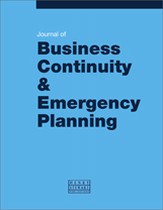Improving the resilience of drinking water and wastewater utilities and emergency management agencies through collaboration
Abstract
Responding to a major disaster requires coordination and communication across all critical infrastructure sectors, including emergency management and drinking water and wastewater. This paper describes how in planning for an earthquake in the Cascadia Subduction Zone, the various bureaus in the City of Portland developed robust relationships by participating in joint exercises and events, coordinating on damage assessments and collaborating on planning efforts. The paper also describes the various tools and resources provided by the US Environmental Protection Agency to help water utilities and emergency management agencies to strengthen their relationships.
The full article is available to subscribers to the journal.
Author's Biography
Kim Parsons Anderson is an emergency manager for the City of Portland Water Bureau. She manages the bureau’s emergency operations centre and maintains its comprehensive emergency operations plan. Kim has served in several activations, including the 2017 Eagle Creek fire response. She has extensive Federal Emergency Management Agency training and is a certified FEMA Incident Command System instructor. Kim is a project manager and administrative professional with organisational management certifications.
Lauren Wisniewski is an environmental engineer for the US Environmental Protection Agency (EPA), Office of Water. She is a member of the EPA’s Response Support Corps and has staffed the Water Desk in EPA’s emergency operation centre during several activations. Lauren has a master of public health from George Washington University and bachelor of science in engineering from Duke University.
Citation
Anderson, Kim Parsons and Wisniewski, Lauren (2019, December 1). Improving the resilience of drinking water and wastewater utilities and emergency management agencies through collaboration. In the Journal of Business Continuity & Emergency Planning, Volume 13, Issue 2. https://doi.org/10.69554/UGBP8150.Publications LLP
